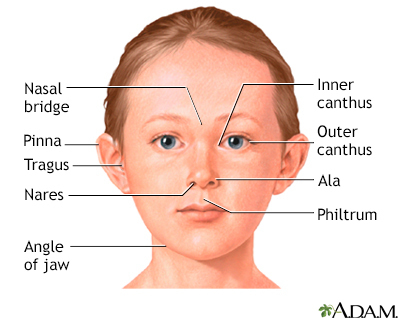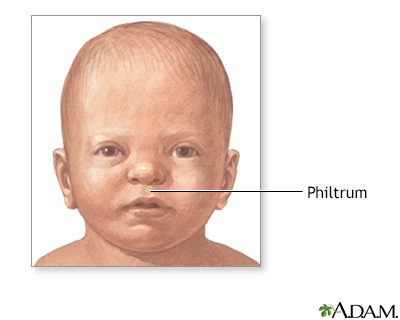Short philtrum
Definition
A short philtrum is a shorter than normal distance between the upper lip and the nose.
Considerations
The philtrum is the groove that runs from the top of the lip to the nose.
The length of the philtrum is passed down from parents to their children through genes. This groove is shortened in people with certain conditions.
Causes
This condition can be caused by:
- Chromosome 18q deletion syndrome
- Cohen syndrome
- DiGeorge syndrome
- Oral-facial-digital syndrome (OFD)
Home Care
No home care is needed for a short philtrum, in most cases. However, if this is only one symptom of another disorder, follow your health care provider's instructions on how to care for the condition.
When to Contact a Medical Professional
Contact your provider if you notice a short philtrum on your child.
What to Expect at Your Office Visit
An infant with a short philtrum may have other symptoms and signs. Taken together, these may define a specific syndrome or condition. The provider will diagnose that condition based on a family history, medical history, and physical exam.
Medical history questions may include:
- Did you notice this when the child was born?
- Have any other family members had this feature?
- Have any other family members been diagnosed with a disorder associated with a short philtrum?
- What other symptoms are present?
Tests to diagnose a short philtrum:
- Chromosome studies
- Enzyme tests
- Metabolic studies on both mother and infant
- X-rays
If your provider diagnosed a short philtrum, you may want to note that diagnosis in your personal medical record.
Gallery


References
Madan-Khetarpal S, Arnold G, Ortiz D. Genetic disorders and dysmorphic conditions. In: Zitelli BJ, McIntire S, Nowalk AJ, Garrison J, eds. Zitelli and Davis' Atlas of Pediatric Physical Diagnosis. 8th ed. Philadelphia, PA: Elsevier; 2023:chap 1.
Sullivan KE, Buckley RH. Primary defects of cellular immunity. In: Kliegman RM, St. Geme JW, Blum NJ, Shah SS, Tasker RC, Wilson KM, eds. Nelson Textbook of Pediatrics. 21st ed. Philadelphia, PA: Elsevier; 2020:chap 151.